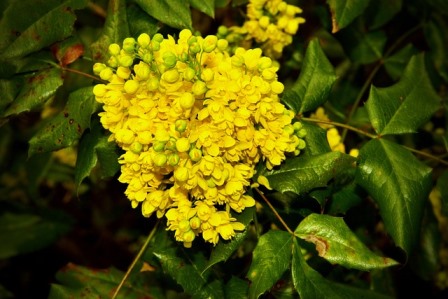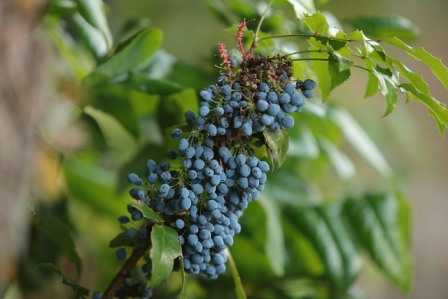 Oregon Grape Image by Elżbieta Michta from PixabayThe various species of Mahonias are commonly called “Oregon Grape”, “Holly Mahonia”, “Holly-leaved Barberry", “Chinese Hollygrape” or “Leatherleaf Mahonia” are loved and grown in gardens and parks in many countries. However, several members of this genus are now known to be aggressive invaders in many of these regions. Does Mahonia also pose a threat to our indigenous flora? Read more below.
Oregon Grape Image by Elżbieta Michta from PixabayThe various species of Mahonias are commonly called “Oregon Grape”, “Holly Mahonia”, “Holly-leaved Barberry", “Chinese Hollygrape” or “Leatherleaf Mahonia” are loved and grown in gardens and parks in many countries. However, several members of this genus are now known to be aggressive invaders in many of these regions. Does Mahonia also pose a threat to our indigenous flora? Read more below.
A good example of an invasive Mahonia species is the “Leatherleaf Mahonia” (Mahonia bealei) a species native to mainland China that can grow from 1.5 to 3 m tall. It was planted as an ornamental and now invades woodlands in the southern United States. It spreads by seed dispersed by birds who relish the fruits, and it also colonises via basal sprouts, forming dense thickets.
Another good example is the well-known “Oregon Grape” or Holly-leaved Barberry (Mahonia aquifolium), a species native to western North America that is still grow in South Africa, but is known to be very invasive in Germany.
If certain Mahonia species are listed as invasive in other countries where they have escaped garden cultivation, should we be concerned about the same thing happening in South Africa. I certainly believe so, and especially since the first naturalised populations of the Chinese Hollygrape, Mahonia oiwakensis (=Mahonia lomariifolia) have been documented in South Africa. They were found in Gauteng, Pretoria, in the Faerie Glen Nature Reserve and Moreleta Kloof Nature Reserve, where they are invading the natural savannah biome, in both thornveld and bushveld vegetation. In order to determine how much of a threat this species poses, further research is considered urgent.
Chinese Hollygrape was also a popular garden plant in many other countries, and in New Zealand, where it is still often still listed as (Mahonia lomariifolia) it is classified as an invasive environmental weed, which has naturalised.
The Chinese Hollygrape is native to China, and was widely cultivated in South Africa as an ornamental plant, but the species is now under surveillance for potential eradication or containment targeting. Some species of Mahonia are reported to re-produce both vegetatively and by seeds, but it is not yet known if this is the case with this species, but if the seed is viable and spread by birds, just the massive quantity of seeds it produces would make it a potential threat.
 Oregon Grape Image by Image Eugen Tomas from PixabayThe Oregon Grape, Holly Mahonia (Mahonia aquifolium) is native to the North American west coast, from British Columbia to northern California, and is the state flower of Oregon. It grows about 1m tall and 75cm wide, and is still cultivated in South Africa because it thrives throughout the country with the exception of our very hot and humid regions, and is an easy to grow evergreen with beautiful dark green holly-like leaves that turn bronze in autumn. In spring, delightful drooping sprays of small, yellow bell-like flowers appear and are followed by small blue-black berries that contain large seeds. The fruits are relished by birds which spread the seeds far and wide.
Oregon Grape Image by Image Eugen Tomas from PixabayThe Oregon Grape, Holly Mahonia (Mahonia aquifolium) is native to the North American west coast, from British Columbia to northern California, and is the state flower of Oregon. It grows about 1m tall and 75cm wide, and is still cultivated in South Africa because it thrives throughout the country with the exception of our very hot and humid regions, and is an easy to grow evergreen with beautiful dark green holly-like leaves that turn bronze in autumn. In spring, delightful drooping sprays of small, yellow bell-like flowers appear and are followed by small blue-black berries that contain large seeds. The fruits are relished by birds which spread the seeds far and wide.
It was introduced from North America into Europe, where it has long been known to be invasive, and because there is evidence of a hybrid origin for this species, it is also likely that invasive populations consist largely of garden hybrids. As a highly bred species, it is thought to have an advantage over its wild relatives, due to the plant breeder’s selection for more flowers and fruit, resulting in the plant having a much higher reproductive potential if the seeds are viable. Rapid clonal growth also takes place through root suckers and stem layering, leading to the formation of large and dense populations that are known to escape regularly from cultivation in private and public gardens to form thickets of woody vegetation that crowds out native species.
Interestingly, in the coastal dunes in Belgium, Mahonia aquifolium is known to produce dense monospecific populations - populations in which all the individual plants are only one species.
I believe that in the future plant breeding will play a huge role for the good when it comes to breeding and assessing plants, not only to produce more flowers or fruits, or perhaps to breed more compact varieties, but also to assess their potential to be invasive before releasing them to the public.
Many invasive plants like the beautiful Snowball Bush, Witbalroos (Viburnum opulus,) which was planted quite extensively outside of its native range and escaped and naturalized itself, have already been modified by breeders who developed sterile plants that do not produce fruits and seeds, but make up for this with the sheer magnificence of their flowers. This led to the creation of several sterile cultivars and varieties that are not invasive.
In the future a lot more attention will be placed on the vital role plant breeding has when assessing the mechanisms required for preventing plant invasions happening in the first place.
Although I never found Mahonia aquifolium listed as an invasive plant in South Africa, I truly believe that we should think long and hard before planting it, or any other Mahonias in our gardens - better to be safe than sorry, the decision is yours!


